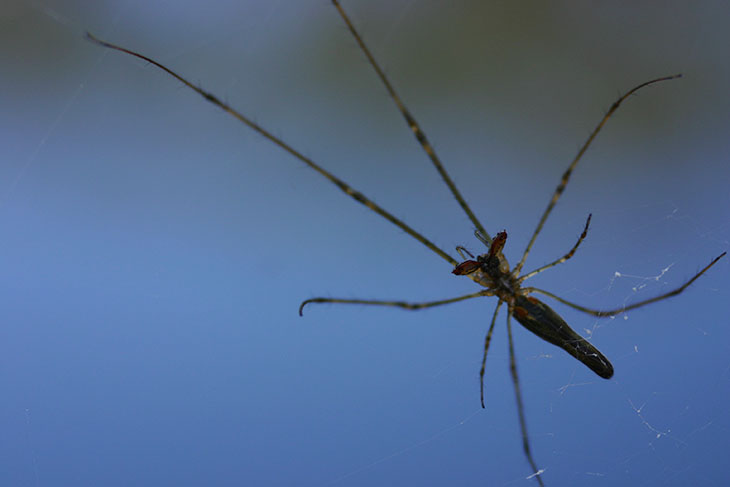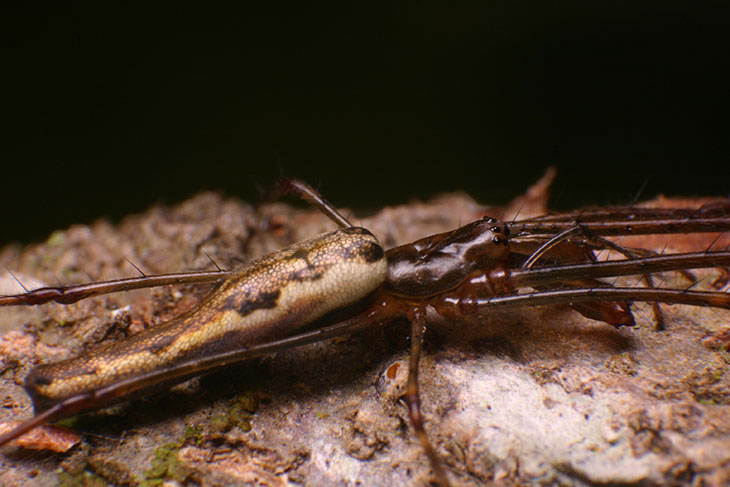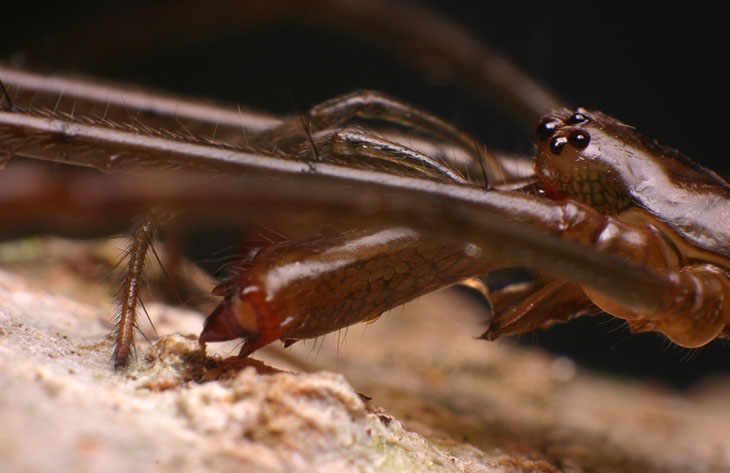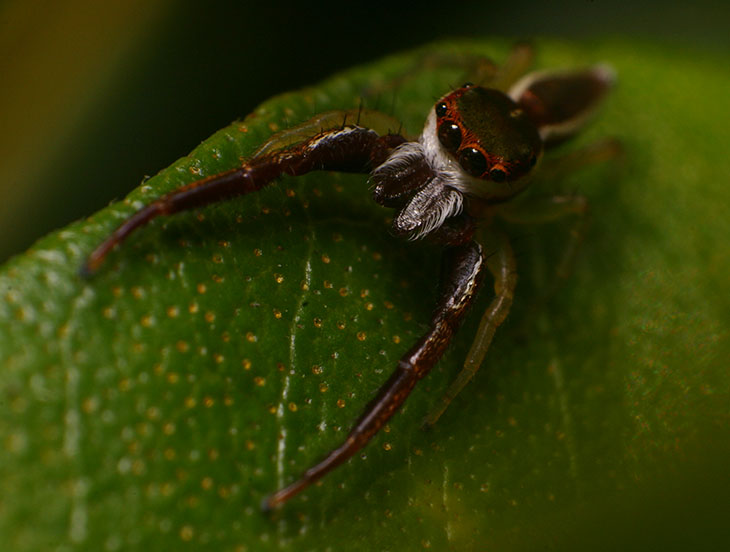
“So, Al,” you begin, (“you” meaning someone who reads this blog regularly, possibly an entirely fictitious character, and not necessarily you yourself, but thank you if it applies,) “are you trying to tell us that you spent all that time in Savannah, the edge of the subtropics, and did almost no insect photography? Seriously?” And to that I reply, “Well, my own area is such crap for landscapes and even sunset images, so I was wisely using the opportunity to fill out my stock in other areas.” So there. But I did indeed chase a couple of arthropodal subjects, including some detail shots of one I’ve had on my list for a short while now.
 Long-jawed orb weavers (genus Tetragnatha) are a curious spider found most often – in my experience, anyway – on trees and reeds alongside water sources, but they also can be very fond of docks and boathouses. They have two outward appearances that are fairly distinctive, which is the pose at right when they’re out in their web over the water (you’re seeing a reflection of the sky in the water, since I’m aiming downwards,) or when threatened, they go to one of their web anchors and draw their legs into a straight line with their narrow bodies, blending into the thin leaves they live near. There are grassland varieties as well, but the aquatic-oriented species are the ones you’re most likely to see, and of course the one I captured here. There is a distinctive feature that they have, their namesake actually, which is only visible when you go in for close examination, and that’s the only warning that you get after the snarky way you opened the topic.
Long-jawed orb weavers (genus Tetragnatha) are a curious spider found most often – in my experience, anyway – on trees and reeds alongside water sources, but they also can be very fond of docks and boathouses. They have two outward appearances that are fairly distinctive, which is the pose at right when they’re out in their web over the water (you’re seeing a reflection of the sky in the water, since I’m aiming downwards,) or when threatened, they go to one of their web anchors and draw their legs into a straight line with their narrow bodies, blending into the thin leaves they live near. There are grassland varieties as well, but the aquatic-oriented species are the ones you’re most likely to see, and of course the one I captured here. There is a distinctive feature that they have, their namesake actually, which is only visible when you go in for close examination, and that’s the only warning that you get after the snarky way you opened the topic.

Here’s a slightly better look from the underside. The widest part of the body is their chelicerae, or fangs if you prefer, but it’s more than just the pointy bits that they stab poor unsuspecting mayflies with, since they’re jointed, manipulating digits. The thin little arms between the front legs are the pedipalps, their girth marking this specimen as a female. But of course I had to go closer, and in doing so, the spider spooked and ran up to the anchoring tree, positioning itself against the bark in camouflage mode.

Here’s the body shot, and no, night did not fall abruptly. I switched to full-on macro mode, which meant diffused flash unit, small aperture, and high shutter speed, and so the background was no longer bright enough to create its own exposure – especially in the early morning when I was doing these shots. Even as spiders go, Tetragnathas are not pretty examples, but you have to admit their abdominal coloration is interesting. And now you can start to get the impression of how disproportionate their chelicerae are – and also that their eye pattern, two rows of four each, is somewhat unnerving. It gives an idea of just how evolution has shaped us to react to certain details, because the eyes are way out of our comfort zone, preventing us from having the least little sympathy with such species.

 Here’s a better look at those chelicerae, the best I managed – my model was shot in situ with only some nudges to try and achieve a better angle, so conditions were a bit limiting. They’re still sufficient to see that the chelicerae are these studded war clubs of appendages, two big cans of whupass with easy-open tops (no, I did not learn my writing style from Shakespeare or Dickens, why do you ask?) While I would like to offer some insight into why Tetragnathas require such huge canines, I’m afraid I’m at a total loss, since their food consists of flimsy slow water flies that certainly don’t seem hard to subdue – perhaps their venom is especially weak so they have to beat their prey to death. As you ponder this, take note of the coloration on the chelicerae and lower ‘face,’ in the image above, continuing the theme from the abdomen and indicating that the carpet does match the drapes (yeah, I’m in one of those moods.)
Here’s a better look at those chelicerae, the best I managed – my model was shot in situ with only some nudges to try and achieve a better angle, so conditions were a bit limiting. They’re still sufficient to see that the chelicerae are these studded war clubs of appendages, two big cans of whupass with easy-open tops (no, I did not learn my writing style from Shakespeare or Dickens, why do you ask?) While I would like to offer some insight into why Tetragnathas require such huge canines, I’m afraid I’m at a total loss, since their food consists of flimsy slow water flies that certainly don’t seem hard to subdue – perhaps their venom is especially weak so they have to beat their prey to death. As you ponder this, take note of the coloration on the chelicerae and lower ‘face,’ in the image above, continuing the theme from the abdomen and indicating that the carpet does match the drapes (yeah, I’m in one of those moods.)
I feel obligated to offer a little perspective, since these closeups may be provoking the wrong impression. Despite the daunting appearance of this species, my models were incredibly shy, as many spiders are, and getting this close took a fair amount of playing around since all the arachnid wanted was to hide. Even as I gently nudged her with a blade of grass, she timidly dodged aside, and eventually scampered off across the bark for a tighter crevice – I don’t think I could have induced a bite if I tried. Sound effects technicians, faced with having to try and find something appropriate for the menacing giant spider in any given horror sequence, resort to chittering, hisses, or even clattering (of the limb joints I guess,) but a more accurate expression would probably be a puppy whining.
I mentioned above something about how we react to eyes, and species like the one below (photographed at the side of the same pond) generate more sympathetic responses from people. Jumping spiders, however, are often fearless little cusses, rarely hesitating to walk across one’s hand or even jump onto the camera, and the easiest to get a portrait perspective on because they’ll actually turn to face whatever approaches. We find the other eyes easy to ignore and focus on those big two, and create a personality for them even when they have no more, and no less, that the Tetragnathas. Humans are weird.





















































